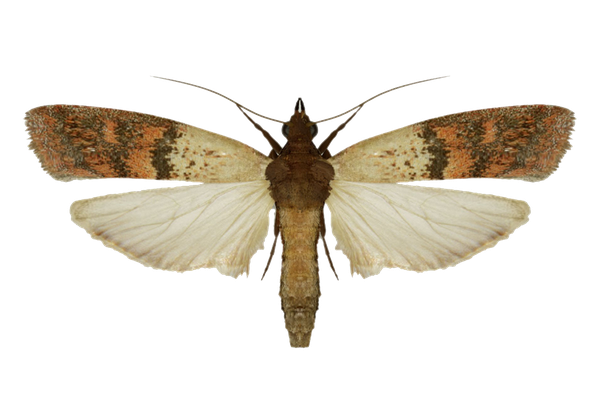| Description | Adults are 8–10 mm in length with 13–20 mm wingspans. The outer half of the moth’s forewings is bronze, copper or dark grey in colour, while the upper half is yellowish-grey. The moth larvae are creamy-white (8-17 mm long) with brown heads. |
|---|---|
| Distribution | Cosmopolitan with a range extending from the tropics to temperate regions. The larvae of this species have the ability to bite through plastic and cardboard; thus, even sealed containers may be infested. |
| Pest status | Major, widespread, regular. |
| Host range | Primarily an external feeding pest. These insects prefer broken grains, grains damaged by other grain pests, and milled cereal products such as flour and cereal flakes / rolls, pasta, as well as spices, nuts and dried fruits. |
| Damage | Direct damage to grain can result from larvae feeding on the seed germ, reducing dry grain weight and quality. The produce they infest will often be webbed together and contaminated with larvae droppings. Severe infestations can be severely detrimental to product quality. |
| Life cycle | Female moths lay between 100–300 eggs singly or in groups of up to 30 on a food surface. Eggs are smaller than 0.5 mm diameter and not sticky. The eggs hatch in 2 to 14 days. Larvae create webbing as they feed. They then pupate in a cocoon-like structure (several grains webbed together in a clump). Life cycle takes about 4–8 weeks under optimal conditions. Temperatures below 20°C can cause a diapause in eggs and larvae with development ceasing completely at temperatures below 10°C. |
| Means of protection |
Cultural control – The insect does not occur in standing crops. Therefore, good hygiene with storage and handling equipment should minimise infection. Prevention treatment by Methograin Delta IGR Grain Protectant is the primarily recommended product for prevention. To gain the widest possible range of protection Methograin Delta IGR Grain Protectant together with Methograin Fenitrothion 1000 can be applied. Chemical control – In case of infestation, fumigation in sealed storage. |
